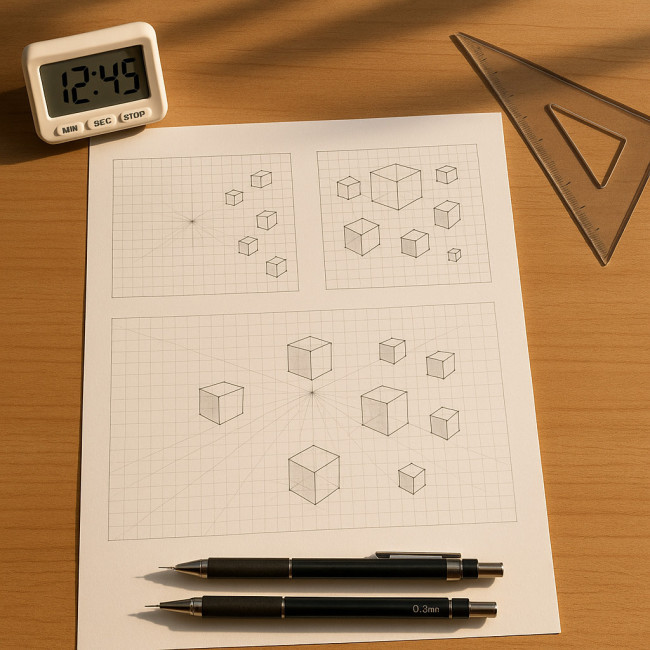Draftsman perspective challenges: daily grids to speed up architectural sketching
Struggling to keep your vanishing points in check when time is tight? Daily grid exercises are a fast, proven way to boost perspective accuracy and shorten delivery cycles on architectural sketches. In this guide, you'll learn why grids work, how to practise them in just 15 minutes a day, and the best ways to turn confidence on paper into billable speed.
Why perspective slows many draftsmen down
Architectural clients expect flawless perspective every time, yet most draftsmen admit they still pause to “feel” their angles. Three blockers explain the friction:
- Invisible construction lines » Erasing and re-drawing eats minutes per sheet.
- Vanishing-point drift » Small misalignments force late-stage corrections.
- Scale inconsistency » Objects near the viewer balloon or shrink, breaking believability.
If each issue costs just two minutes per drawing and you sketch 10 views a week, that is one extra hour lost—time you could spend refining line weight or billing another mini-project.
The daily grid workout
Grids create muscle memory the way scales train a pianist. Follow the ladder below: one-point to three-point perspective in under a month.
Week 1: One-point grid (A5 sheet, 5 min)
- Draw a horizon line across the centre.
- Select a single vanishing point (VP) on that line.
- Rule five verticals, then fan ten “vision lines” from the VP across the sheet.
- Fill each square with a quick door, window or column.
Outcome: You rehearse spacing objects evenly as they recede, ideal for corridor or façade sketches.
Week 2: Two-point grid (A4 sheet, 7 min)
- Horizon mid-height; place two VPs far apart.
- Draw a centre vertical line to mark the nearest edge of a cube.
- Project diagonals to both VPs, generating left and right faces.
- Add guide lines every 1 cm to monitor convergence.
Outcome: Street-corner scenes become second nature, and you visualise roof pitches faster.
Weeks 3-4: Three-point “tower” grid (A4 portrait, 10 min)
- Keep the two horizon VPs. Place a third VP well above or below the sheet.
- Sketch a quick prism using all three VPs.
- Overlay a transparent sheet and repeat the prism at new heights and rotations.
- Finish with annotation—height, angle, focal length estimate.
Outcome: High-rise concepts or worm's-eye interior views no longer intimidate you.
Time-savings you can expect
| Stage | Avg. time before grids | Avg. time after 30-day plan | Gain |
|---|---|---|---|
| Blocking horizon & VPs | 4 min | 1 min | −75 % |
| Setting object widths | 6 min | 3 min | −50 % |
| Error corrections | 5 min | 1 min | −80 % |
Total saved per sketch: roughly 10 minutes. Multiply by a five-view concept board and you reclaim almost an hour—exactly the margin many studios charge as an express fee.
Tool kit: minimal gear, maximal impact
- 0.3 mm mechanical pencil for faint grids, 0.5 mm for final lines.
- Transparent 30/60° set square: locks verticals fast.
- Mini rotating ruler or drafting app grid layer for digital practice.
- Timer or Pomodoro app to enforce the 15-minute cap.
Turning drills into profit

Speed alone does not pay the bills—you must show it off. Add time-lapse clips of your grid warm-ups to a portfolio section focused on production efficiency. When pitching, reference the savings to support a rush-fee justification. For more positioning tips, review how clear online briefs and freelance retainer agreements convert agility into recurring revenue.
Common mistakes and quick fixes
Choosing wrong eye level
Misplaced horizons distort human-scale cues. Solution: mark eye level first—roughly 1.6 m for street scenes—before grid lines.
Over-erasing
Heavy erasing scars paper fibres. Draw grid lines at 20 % pressure; switch to darker leads only for final lines.
Ignoring focal length
If a client specifies a 35 mm lens, keep VPs close. Wider lenses (18–24 mm) push VPs off the sheet; note this in the margin to avoid redrafts.
Advance your craft further
Once grids become muscle memory, upgrade your bio with process GIFs and SEO keywords. The article on permit-ready drawings shows how to underline technical rigor, while our guide to an architect bio that ranks reveals metadata tweaks that surface your work in competitive searches.
For structured online workshops, the curated programmes listed on professional image-designer training pages provide peer feedback and credential badges valued by real-estate developers.
Quiz: Test your perspective reflexes
FAQ
- Do I need fancy software to practise grids?
- No. A pencil, ruler and cheap printer paper are enough. Digital layers in SketchBook or Procreate are optional boosters.
- How long before I see speed improvements?
- Most draftsmen report noticeable gains after two weeks of consistent 15-minute sessions.
- Will grids limit my creative style?
- Quite the opposite—once perspective is automatic, you free up cognitive load for textures, lighting and storytelling.
- Can I apply the method to 3D CAD?
- Yes. Practising grids sharpens spatial reasoning, reducing viewport adjustments in BIM or Rhino by roughly 30 %.
Key takeaway
Daily grid drills compress the time you spend wrestling with perspective, turning architectural sketches into a lean, profitable workflow. Start today: set a timer for 15 minutes, pick the grid of the week, and watch both your accuracy and hourly rate climb.
Ready to go deeper? Subscribe to our newsletter for weekly sketch templates and advanced perspective breakdowns.











